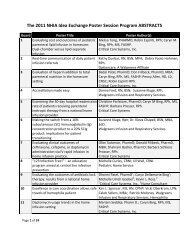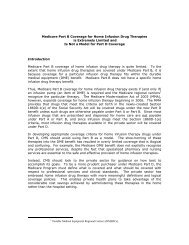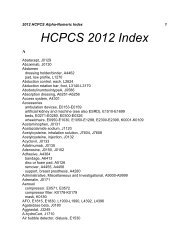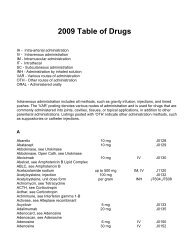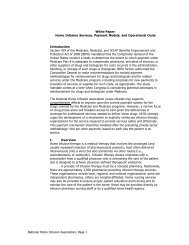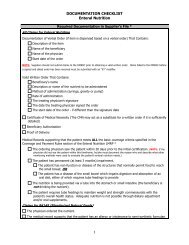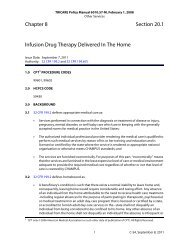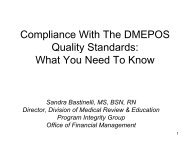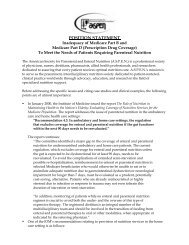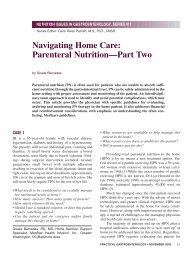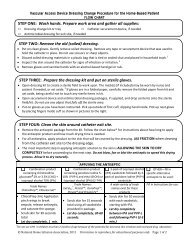In some states, reducing avoidable ER use in <strong>Medicaid</strong> is part of a state-wide effort that may also involveother payers, statewide educati<strong>on</strong> efforts, establishment of nurse advice lines, and collaborati<strong>on</strong> am<strong>on</strong>ghospitals, health plans, and primary care providers. These initiatives often include the development ofdiversi<strong>on</strong> protocols that redirect people with n<strong>on</strong>-emergent needs to appropriate sites for care, such asa nearby clinic or their primary care provider. Some ER-related efforts are part of a chr<strong>on</strong>ic caremanagement initiative that focuses <strong>on</strong> individuals with specific diseases, such as asthma, diabetes,hypertensi<strong>on</strong>, or c<strong>on</strong>gestive heart failure. <strong>State</strong> medical home initiatives also include a focus <strong>on</strong> reducinginappropriate ER use and ensuring that care is provided in the appropriate setting. Most states areevaluating the effectiveness of their efforts to reduce ER use. Some states, but not all, reported reducedER use resulting from state initiatives.Most states report initiatives to address obesity, with <strong>Medicaid</strong> MCOs often playing a leading role.<strong>State</strong> <strong>Medicaid</strong> programs have a large stake in efforts to reduce obesity because many <strong>Medicaid</strong>beneficiaries suffer from chr<strong>on</strong>ic c<strong>on</strong>diti<strong>on</strong>s related to obesity, such as diabetes. Initiatives to m<strong>on</strong>itorand reduce obesity were reported by 34 states, with <strong>Medicaid</strong> MCOs often playing a key role. Toillustrate, in Michigan, all <strong>Medicaid</strong> MCOs are required to c<strong>on</strong>duct a performance improvement project(PIP) <strong>on</strong> childhood obesity, which must be evaluated by the EQRO. California and Tennessee require<strong>Medicaid</strong> MCOs to report scores annually for the HEDIS© measure “Weight Assessment & Counselingfor Nutriti<strong>on</strong> & Physical Activity for Children and Adolescents,” and other states have added otherHEDIS© measures relating to BMI. In some cases, MCOs have developed their own weight-reducti<strong>on</strong> ordisease management programs for obese adult and child enrollees. A number of <strong>Medicaid</strong> programs areparticipating in state-wide obesity initiatives that involve surveys, data collecti<strong>on</strong>, educati<strong>on</strong>, and healthpromoti<strong>on</strong>.All Tenn<strong>Care</strong> MCOs have implemented a disease management (DM) obesity program for children and adults withparticipants identified through self-referral, physician referral, and community referrals, and through other DMand care management (CM) program engagement, such as health risk assessments. Risk stratificati<strong>on</strong>, typicallybased <strong>on</strong> Body Mass Index and/or co-occurring c<strong>on</strong>diti<strong>on</strong>s, determines the type and intensity of interventi<strong>on</strong>s,which can include educati<strong>on</strong>al material addressing nutriti<strong>on</strong>, exercise and weight management, referrals tocommunity partners that supply weight management programs, and individual care plans addressing weight loss.The DM obesity programs are evaluated annually based <strong>on</strong> both process and outcome measures.About half the states report initiatives in <strong>Medicaid</strong> to address racial and ethnic disparities, includingparticipati<strong>on</strong> in broader state efforts. Because of <strong>Medicaid</strong>’s large role in paying for births and coveringcommunities of color, the program is instrumental to efforts to narrow racial and ethnic disparities inaccess, care, and outcomes related to major chr<strong>on</strong>ic diseases. Federal regulati<strong>on</strong>s require states toprovide their c<strong>on</strong>tracted MCOs with data <strong>on</strong> the race and ethnicity of their <strong>Medicaid</strong> enrollees to allowhealth plans to measure, m<strong>on</strong>itor, and address disparities.Just under half of state <strong>Medicaid</strong> programs (24 states) reported that they had or would have qualityinitiatives in <strong>Medicaid</strong> specifically to address racial and ethnic disparities. Numerous states reportedformal <strong>Medicaid</strong> PIPs focused <strong>on</strong> reducing racial and ethnic disparities in certain measures (e.g.,adolescents’ use of well-child visits, breast or cervical cancer screening rates), or <strong>on</strong> culturalcompetency. In <strong>on</strong>e state, each MCO has a “disparity committee” that analyzes data by race andethnicity and recommends interventi<strong>on</strong>s for the plan to implement. Several states analyze quality databy race and ethnicity, including <strong>on</strong>e state that publishes the data. A number of states reported broader40 00
public health efforts to reduce disparities, with <strong>Medicaid</strong> participating in interagency and communitytask forces and statewide collaboratives.Wisc<strong>on</strong>sin has implemented several efforts to reduce racial/ethnic disparities in poor birth outcomes. Oneincludes a medical home pilot project in the southeast regi<strong>on</strong> of the state, and a financial penalty for healthplans that fail to provide appropriate care for pregnant women who then have a poor birth outcome.Washingt<strong>on</strong> examines immunizati<strong>on</strong> data for racial/ethnic disparities. Having identified disparities in theRussian-speaking populati<strong>on</strong>, the state plans focus groups in 2011 to better understand the root causes ofunder-immunizati<strong>on</strong> of Russian-speaking children.<strong>State</strong>s reported a broad spectrum of other, special managed care quality initiatives. A total of 26states reported managed care quality initiatives in a host of additi<strong>on</strong>al areas, reflecting diverse prioritiesand strategies. Am<strong>on</strong>g others, they menti<strong>on</strong>ed quality initiatives focused <strong>on</strong>: perinatal care anddepressi<strong>on</strong> screening; improved care management for individuals with both behavioral health diagnosesand chr<strong>on</strong>ic c<strong>on</strong>diti<strong>on</strong>s; identificati<strong>on</strong> of high-risk enrollees for intensive case management; dentalutilizati<strong>on</strong>; and improving the data available to providers to benchmark their performance. Many of theinitiatives involve strategic use of HEDIS© and CAHPS© data by states and plans, to measure andm<strong>on</strong>itor quality and drive improvement, sometimes via P4P approaches. In some states, the activity in<strong>Medicaid</strong> is part of a broader, statewide quality initiative.Ariz<strong>on</strong>a AHCCCS has formed work groups with c<strong>on</strong>tracted health plans and community stakeholders to addressissues such as low rates of breast and cervical cancer screening, childhood immunizati<strong>on</strong>s and well-child visits,and the need for better care management of members with behavioral health diagnoses who also have chr<strong>on</strong>icc<strong>on</strong>diti<strong>on</strong>s or development of toolkits for management by PCPs of some behavioral c<strong>on</strong>diti<strong>on</strong>s such as anxiety,depressi<strong>on</strong> and ADHD. The work groups allow c<strong>on</strong>tractors, in c<strong>on</strong>juncti<strong>on</strong> with public agencies and othercommunity providers, to identify barriers, collaborate <strong>on</strong> interventi<strong>on</strong>s and share promising practices.Initiatives to improve primary care and care coordinati<strong>on</strong>A large majority of <strong>Medicaid</strong> programs have a medical home initiative in place or under development.<strong>State</strong> <strong>Medicaid</strong> programs have l<strong>on</strong>g used the term “medical home” to capture the c<strong>on</strong>cept of firmlyc<strong>on</strong>necting the <strong>Medicaid</strong> enrollee with a particular primary care provider who has agreed to guaranteetimely access when care is needed. In recent years, the term has also taken <strong>on</strong> a more specific andcomprehensive meaning, associated with NCQA’s “Physician Practice C<strong>on</strong>necti<strong>on</strong>s® - Patient CenteredMedical Home” program, which recognizes providers who meet a set of specified benchmarks asmedical home providers. 20Interest in medical homes spans public and private health insurers and payers, including <strong>Medicaid</strong>. In all,39 states reported having a medical home initiative in place (27 states) or under development (12states).A large majority of states have disease and/or care management programs, which are oftenintegrated into their managed care programs. Recognizing that a very small share of <strong>Medicaid</strong>beneficiaries with very high needs and costs account for a large share of <strong>Medicaid</strong> spending, states haveincreasingly turned to disease management (DM) and care management (CM) programs to improve carefor people with specific chr<strong>on</strong>ic c<strong>on</strong>diti<strong>on</strong>s. Early programs tended to focus narrowly <strong>on</strong> management of20 NCQA. See: http://www.ncqa.org/tabid/631/Default.aspx41
- Page 1 and 2: kaisercommission onmedicaidand theu
- Page 3 and 4: kaisercommission onmedicaidand theu
- Page 5 and 6: Table of ContentsExecutive Summary
- Page 7 and 8: EXECUTIVE SUMMARYMedicaid, the publ
- Page 9 and 10: party enrollment brokers to provide
- Page 11 and 12: HEDIS©, CAHPS©, and state-specifi
- Page 13: ConclusionFor over 30 years, state
- Page 16 and 17: from the recession and the slow rec
- Page 18 and 19: A note on Medicaid managed care ter
- Page 20 and 21: Managed caremodelTable 1: Medicaid
- Page 23 and 24: States are increasingly mandating m
- Page 25 and 26: States with Medicaid MCOsKey Sectio
- Page 27 and 28: States have “auto-assignment” a
- Page 29 and 30: excess of a specified threshold for
- Page 31 and 32: Dental care and outpatient and inpa
- Page 33 and 34: the second trimester, and within th
- Page 35 and 36: eported that they limit PCP panel s
- Page 37 and 38: States with non-comprehensive PHPsK
- Page 39 and 40: Measuring, monitoring, and improvin
- Page 41 and 42: seven states required 10 measures o
- Page 43 and 44: CAHPS© surveys. North Carolina is
- Page 45: Special initiatives to improve qual
- Page 49 and 50: Medicaid managed long-term care and
- Page 51 and 52: (e.g., need to credential Adult <st
- Page 53 and 54: In many states, broader efforts foc
- Page 55 and 56: Looking ahead: Medicaid managed car
- Page 57 and 58: ConclusionFor over 30 years, state
- Page 59 and 60: APPENDIX 2: Summary of Medicaid Man
- Page 61 and 62: Program Name(e.g., Popular Name, 19
- Page 63 and 64: APPENDIX 3: MCO Contracts, Plan Cha
- Page 65 and 66: State(No. ofcontracts)NameEnrollmen
- Page 67 and 68: State(No. ofcontracts)NameEnrollmen
- Page 69 and 70: APPENDIX 5: MCO Capitation Rate-Set
- Page 71 and 72: APPENDIX 7: MCO Network Adequacy Re
- Page 73 and 74: State Primary Care Obstetric Care S
- Page 75 and 76: APPENDIX 9: Providers Recognized as
- Page 77 and 78: APPENDIX 11: PCCM Administrative Se
- Page 79 and 80: APPENDIX 13: Initiatives to Improve
- Page 81 and 82: I. MANAGED CARE OVERVIEW1. Total Ma
- Page 83 and 84: 4. Enrollment Requirements.a. We ar
- Page 85 and 86: ii. Please indicate whether the fac
- Page 87 and 88: c. Required Providers: We are inter
- Page 89 and 90: IV. NON-COMPREHENSIVE PREPAID HEALT
- Page 91 and 92: . Does your state use CAHPS© surve
- Page 93 and 94: VI. SPECIAL INITIATIVESAll states s
- Page 95 and 96: Appendix I: Managed Care Contracts1
- Page 97:
Appendix II: Clinical Quality Perfo
- Page 100:
1330 G S T R E E T NW, W A S H I N



